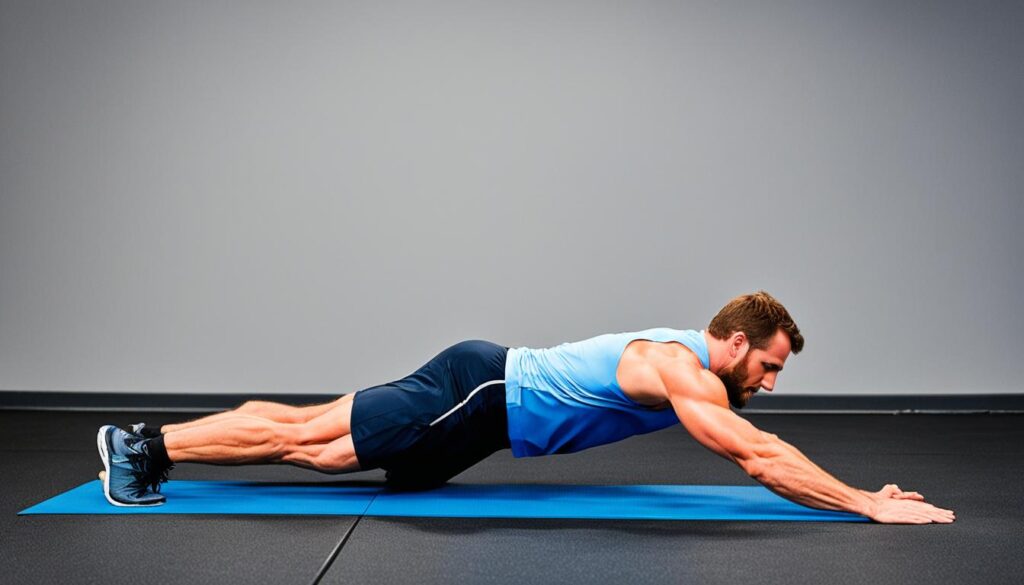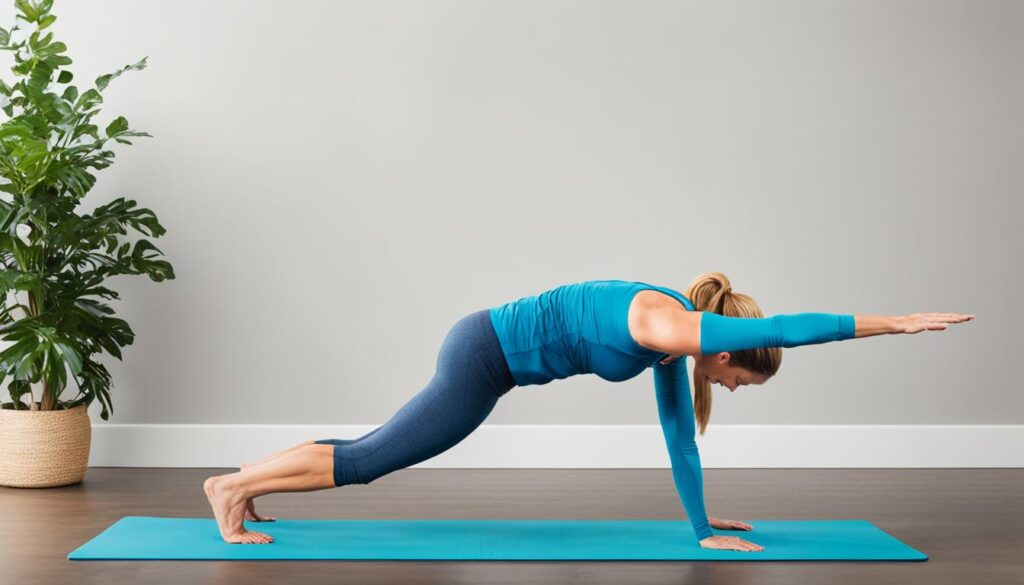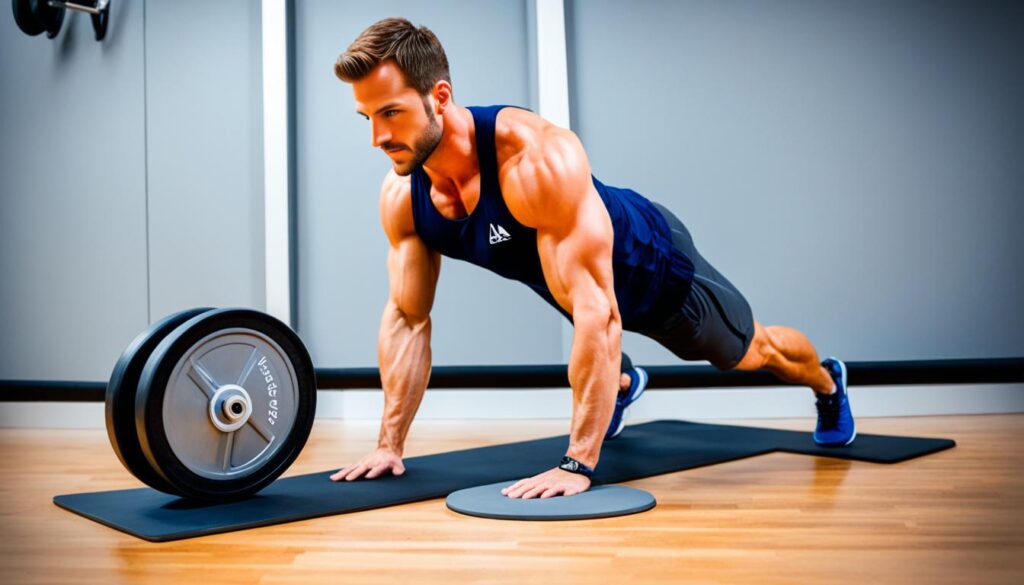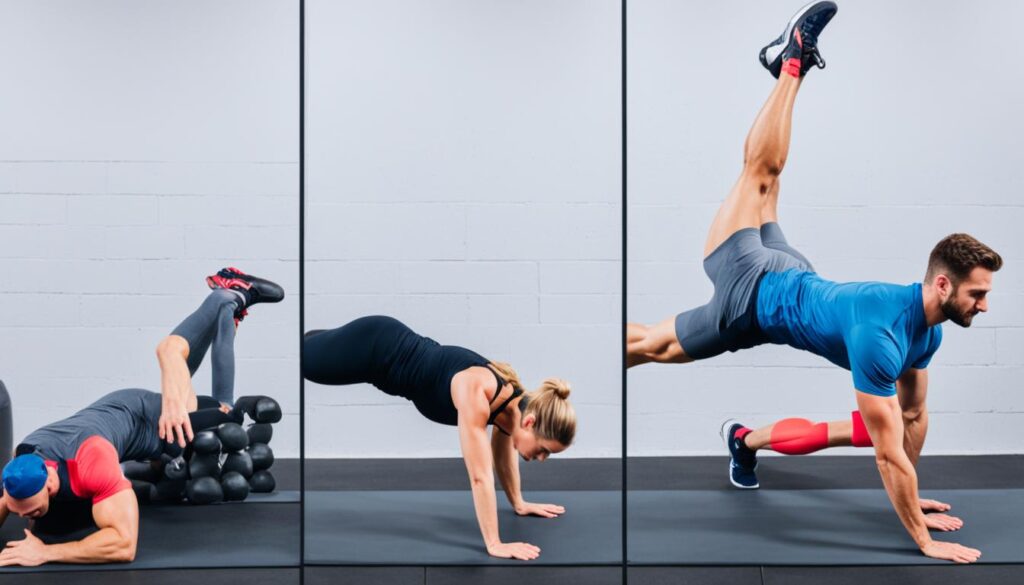Do you struggle to maintain good posture or find it difficult to perform everyday tasks with ease? The key to unlocking your full physical potential may lie in strengthening your core muscles1. Core-strength exercises aim to strengthen the abdominal muscles, back muscles, and muscles around the pelvis, making it easier to do many physical activities1. But which core exercises are truly the best for building a stronger midsection? Let’s dive in and explore the top-performing exercises to take your core strength to new heights.
Key Takeaways
- Core-strength exercises are essential for improving posture, stability, and overall physical performance.
- 1 Recommended repetitions for core-strength exercises range from 12 to 15 per set.
- 1 Exercises like planks, mountain climbers, and side planks are highly effective for targeting the core muscles.
- 1 Consultation with a healthcare professional is advised before starting a core-strengthening routine, especially for individuals with back problems or other health concerns.
- 2 Varying core exercises in different directions helps challenge the core muscles effectively.
What are the Best Core Exercises for a Stronger Midsection?
Building a strong core is essential for overall fitness and performance. The core muscles, which include the abdominals, obliques, and lower back, play a crucial role in stabilizing the spine and supporting a wide range of movements3. By engaging the lower abdominal muscles through exercises like mountain climbers, leg drops, and hip lifts, you can improve stability, mobility, and spinal health3.
Some of the most effective core-strengthening exercises include:
- Planks: This classic exercise engages the entire core, including the transverse abdominis, rectus abdominis, and obliques4.
- Mountain Climbers: This dynamic exercise targets the abs, hip flexors, and shoulders, while also raising the heart rate3.
- Hollow Holds: This isometric exercise challenges the lower abdominal muscles and helps improve core stability4.
- Side Planks: This exercise targets the obliques and helps improve overall core strength and stability4.
- Bird Dog: This exercise works the core, lower back, and glutes, promoting better balance and coordination5.
- Kettlebell Windmill: This exercise engages the obliques, shoulders, and hips, enhancing overall core strength5.
- Ab Wheel Rollout: This exercise challenges the abs, shoulders, and lower back, building strength and stability5.
- Ball Slam: This explosive exercise targets the core, shoulders, and legs, improving power and coordination5.
- Pallof Press: This anti-rotation exercise strengthens the core, particularly the obliques, and improves stability4.
When incorporating these best core exercises into your routine, remember to focus on proper form, breathe deeply, and gradually increase the intensity and duration3. Consult with a fitness professional or healthcare provider before starting any new exercise program, and be mindful of your body’s limits to avoid injury3. By consistently practicing these top core exercises, you’ll build a stronger, more stable midsection that will support your overall fitness goals3.
Incorporating these effective core workouts into your fitness routine can lead to significant improvements in posture, balance, and overall physical performance3. Remember to listen to your body, gradually increase the intensity, and stay consistent for the best results345.
Importance of a Strong Core
The core muscles play a crucial role in our overall physical well-being and performance. These muscles, which include the transverse abdominis, rectus abdominis, external obliques, and internal obliques, work together to control the movement of the spine, pelvis, and rib cage during various activities6. A strong core is essential for improving balance and stability, as it trains these muscles to work in harmony, leading to better balance and steadiness essential for physical activities and sports6.
Core Muscles and Their Functions
The core muscles are responsible for a wide range of functions, from maintaining proper posture to facilitating efficient movement. The transverse abdominis, for instance, acts as a natural corset, stabilizing the spine and pelvis. The rectus abdominis, often referred to as the “six-pack” muscles, are responsible for the flexion of the spine, while the external and internal obliques assist in lateral bending and rotation of the trunk7.
Benefits of a Strong Core
A strong core offers numerous benefits6. It makes it easier to perform various physical activities, such as swinging a golf club or bending down to tie your shoes, showcasing the practical benefits of core strength in daily tasks6. Additionally, weak core muscles can increase the risk of poor posture, lower back pain, and muscle injuries, highlighting the importance of core exercises for injury prevention and overall musculoskeletal health6.
Core exercises are also key to reaching fitness goals, as they complement aerobic exercise and strength training to create a well-rounded fitness program that enhances overall physical conditioning6. Research studies have been conducted to evaluate the effectiveness of core exercises, including systematic reviews on core muscle activity during physical fitness exercises, the effects of core training on dynamic balance stability, and the effectiveness of core stability exercises in patients with non-specific low back pain6.
In conclusion, developing a strong core is crucial for overall physical health, injury prevention, and performance enhancement. By understanding the anatomy and functions of the core muscles, and incorporating targeted core exercises into your fitness routine, you can unlock the full potential of your body and move with greater ease and efficiency7.
Anatomy of the Core Muscles
Understanding the core muscle anatomy is crucial for designing an effective workout routine that targets all the key muscle groups. The core is not just the abdominal muscles; it comprises a complex network of muscles that work together to stabilize the spine, support the trunk, and enable efficient movement8.
Transverse Abdominis
The transverse abdominis is the deepest of the abdominal muscles, forming a muscular corset around the trunk. This muscle plays a vital role in stabilizing the spine and enhancing overall core strength8.
Rectus Abdominis
The rectus abdominis, commonly known as the “six-pack” muscles, runs vertically along the front of the abdomen. This muscle is responsible for the flexion and bending of the spine, contributing to a strong and sculpted midsection9.
External Obliques
The external obliques are located on the sides of the abdomen, running diagonally from the lower ribs to the pelvis. These muscles facilitate trunk rotation and lateral flexion, essential for activities that require twisting and bending movements8.
Internal Obliques
Beneath the external obliques, the internal obliques form another layer of diagonal abdominal muscles. These muscles assist with both trunk rotation and lateral flexion, complementing the actions of the external obliques8.
| Core Muscle | Function |
|---|---|
| Transverse Abdominis | Stabilizes the spine and core |
| Rectus Abdominis | Flexes and bends the spine |
| External Obliques | Facilitates trunk rotation and lateral flexion |
| Internal Obliques | Assists with trunk rotation and lateral flexion |
Incorporating exercises that target these core muscle groups can help improve overall core strength, stability, and performance in various physical activities8109.
Plank Exercise
The plank is a hallmark core-strengthening exercise that challenges the abdominal muscles to stabilize the spine and maintain a straight body line from head to heels11. Plank exercises work all the muscles in the core, including the rectus abdominis, transverse abdominis, internal and external obliques, hips, and back11. Additionally, plank exercises recruit muscles in the legs, arms, and glutes, making it a total-body exercise11.
To properly execute a plank, you should stack your elbows directly under your shoulders, squeeze your glutes and core to create full-body tension, and avoid sagging the hips or arching the back11. The recommended duration for holding each plank exercise ranges from 30 seconds to 1 minute, with a suggestion to work up to longer holds11.
The plank exercise routine provided consists of a series of six plank exercises to be repeated three times in total for a strong core workout11. One specific plank variation involves lifting one foot a few inches off the floor while in a forearm plank position and engaging the glutes11. Side planks target the oblique muscles and involve holding the position for 30 seconds to 1 minute on each side11. An advanced plank variation includes lifting one leg as high as possible while in a side plank position, aiming for 10 repetitions per leg11. A challenging plank variation involves tapping alternate shoulders while maintaining a high plank position for 30 seconds to 1 minute11.
Incorporating the plank exercise into your core workout routine can help build a strong, stable midsection and improve overall body strength and stability11. The plank is a versatile exercise that can be modified to suit various fitness levels and target specific muscle groups, making it an essential component of a comprehensive core-strengthening program11.
Mountain Climbers
Mountain climbers are a dynamic, core-strengthening exercise that challenge your entire body, from your shoulders to your hips. This high-intensity movement not only targets your abdominal muscles but also engages your cardiovascular system, making it an effective addition to any workout routine12.
How to Perform Mountain Climbers
To perform mountain climbers, start in a high plank position with your hands stacked directly under your shoulders. Engage your core by squeezing your glutes and keeping your body in a straight line from head to heels12. Begin by driving one knee up towards your chest, then alternate legs, maintaining a brisk pace while keeping your torso still12. You can experiment with different tempos, ranging from quick, explosive movements to a slower, controlled pace, depending on your fitness level and the desired intensity of your workout12.
For an effective mountain climber routine, try setting a timer for 6 minutes and alternating 20 seconds of work with 10 seconds of rest12. As you build strength and endurance, you can gradually increase the work period to 30 seconds or more, focusing on maintaining proper form and engaging your core throughout the movement12.
Mountain climbers are a versatile exercise that can be incorporated into a variety of workout programs. In a recent article, Amber Rees designed a circuit that included 5 different variations of mountain climbers, with each exercise performed for 30 seconds, followed by 15 seconds of recovery13. The circuit was then repeated three times, providing a comprehensive core and cardio workout that is essential for cycling performance13.
When incorporating mountain climbers into your routine, it’s important to remember to hit all aspects of the trunk, not just the front abs14. Experts recommend doing three or more core exercises at least three to five times a week for best results, while also allowing for one to two rest days per week to allow for muscle recovery14. If you have a history of back or neck problems, it’s always a good idea to consult a doctor before starting high-intensity exercises like mountain climbers14.
By adding mountain climbers to your workout regimen, you can develop a stronger, more stable core, improve your overall fitness, and challenge yourself with a dynamic, full-body exercise. Embrace the burn and watch as your core strength and cardiovascular endurance reach new heights.
Hollow Hold
The hollow hold exercise is a remarkably effective core-strengthening maneuver that targets the transverse abdominis and teaches proper spine positioning15. Described as surprisingly challenging yet highly functional, this exercise is a staple for gymnasts and fitness enthusiasts alike, known for its ability to refine core bracing – a crucial function of the core muscle group15.
To perform the hollow hold, lie on your back with legs extended and arms overhead. Engage your abs to press your lower back into the floor and lift your shoulders, arms, and legs a few inches off the ground, creating a “hollow” body shape15. This isometric contraction targets multiple muscle groups, including the rectus abdominis, transverse abdominis, obliques, lower back, and hip flexors16.
The hollow hold is considered an intermediate to advanced core exercise, less commonly performed compared to other staples like planks or crunches16. However, its effectiveness in building strength, muscular endurance, and core stability is unparalleled16. Mastering this exercise can aid in better posture and executing advanced movements like handstands or pull-ups16.
Variations of the hollow hold, such as the weighted hollow hold, uneven hollow hold, hollow body rock, and gator roll, can further challenge the core and increase the difficulty15. Scaling options, such as modifying arm and leg positions, allow users to adjust the exercise to their fitness level15.
Proper form is crucial during the hollow hold to maximize effectiveness and prevent common mistakes. The recommended programming is three to four rounds of 45-second to one-minute holds, emphasizing the importance of maintaining tension in the core throughout the exercise15.
Research studies have demonstrated the benefits of isometric core exercises like the hollow hold, including pain reduction and increased muscle activity in individuals with low back pain, as well as the positive impact on core and torso stiffness with long-term training17. Whether you’re a seasoned athlete or just starting your fitness journey, the hollow hold is a must-add to your core-strengthening routine17.

“The hollow hold is a surprisingly difficult and effective exercise for building strong, functional core muscles.”15
Side Plank
The side plank is a highly effective exercise that targets the oblique muscles along the sides of your core. This exercise is particularly beneficial for building core stability and strength through lateral flexion18. To perform a side plank, lie on your side, prop yourself up on your forearm, and raise your hips to create a straight line from head to heels1819.
Side Plank Variations
There are several variations of the side plank exercise that can help challenge your core in different ways. Here are some of the most effective side plank variations:
- Modified Side Plank: This beginner-friendly variation is recommended for those new to the exercise, as it helps strengthen the core without risking injury18.
- Forearm Side Plank: This version maximizes core recruitment by lifting the hips as high as possible, challenging the muscles even more18.
- Side Plank With Abduction: Adding hip abduction to the side plank recruits more of the glutes and core, further enhancing the challenge18.
- Side Plank With Hip Raise: This dynamic movement requires more core strength and engages the side of the torso18.
- Forearm Side Plank With Rotation: This advanced variation works the body in multiple planes, demanding additional core stability to maintain balance18.
When performing side plank exercises, it’s important to maintain proper form and avoid straining the shoulders. Experts recommend holding each side plank for 20 to 30 seconds, and not performing all six variations in a single circuit to prevent overexertion18. An exercise mat is optional, but can provide additional comfort and support during the side plank exercises18.
The side plank exercise offers numerous benefits, including improved core strength, stability, efficiency, and performance, particularly for cyclists1819. By incorporating a variety of side plank variations into your workout routine, you can effectively target and strengthen your oblique muscles, contributing to a well-rounded and functional core.
“Side planks can be intensified by using a fit ball or BOSU ball, and in yoga, the Side Plank Pose is taught with the supporting arm straight, increasing the challenge.”19
| Side Plank Variation | Description | Benefits |
|---|---|---|
| Modified Side Plank | A beginner-friendly version that helps strengthen the core without risking injury. | Allows for safe core strengthening and progression to the full side plank. |
| Forearm Side Plank | Maximizes core recruitment by lifting the hips as high as possible. | Challenges the muscles even more by increasing the demand on the core. |
| Side Plank With Abduction | Adds hip abduction to the side plank, recruiting more of the glutes and core. | Enhances the challenge by engaging additional muscle groups. |
| Side Plank With Hip Raise | A dynamic movement that requires more core strength and engages the side of the torso. | Targets the core in a more challenging and functional way. |
| Forearm Side Plank With Rotation | An advanced variation that works the body in multiple planes, demanding additional core stability. | Improves overall core strength, balance, and muscle coordination. |
Remember, the key to effective side plank exercises is maintaining proper form, gradually increasing the challenge, and incorporating a variety of variations to target your obliques and core from different angles. By incorporating these exercises into your workout routine, you can build a stronger, more stable midsection and enhance your overall athletic performance181920.
Bird Dog Exercise
The bird dog exercise is a deceptively challenging core stability exercise that targets multiple muscle groups simultaneously21. This movement requires complete control of the core and whole-body tension for effective execution21. The bird dog exercise challenges the core muscle group in multiple ways, emphasizing balance, stability, and posture21.
To perform the bird dog exercise, start on your hands and knees, engaging your abdominal muscles to keep your spine neutral21. Slowly extend your opposite arm and leg, keeping your torso from rotating and your hips from shifting21. The bird dog trains anti-rotation and improves overall core strength21.
The bird dog exercise, also known as the quadruped exercise, targets the abdominals, lower back, gluteal muscles, and thigh muscles22. It is considered an intermediate-level exercise, and the recommended aim is to complete five reps on each side or 10 reps in total22. Additional sets of 10 exercises can be added, with a maximum of three sets22.
The bird dog exercise is beneficial for building low back function and engaging both core and back muscles simultaneously22. It involves various muscle groups, including the erector spinae, rectus abdominis, obliques, gluteus maximus, trapezius, deltoids, hamstrings, gluteal muscles (medius and minimus), piriformis, obturator externus, pectoralis, serratus muscles, and triceps22.
The bird dog exercise is often recommended by athletic trainers and physical therapists for its ability to reduce low back pain and enhance spinal stability for daily activities involving bending and twisting22. Proper form is crucial to effectively target the intended muscle groups and prevent common form mistakes22.
The bird dog exercise targets the erector spinae, rectus abdominis, and glutes, promoting correct movement, control, and stability of the body23. It is ideal for individuals with low back concerns, including hypermobility, and aids in developing good balance and posture23. Variations like weighted bird dog, elbow to knee extensions, and pulse movements can increase resistance and challenge the core muscles23.
Overall, the bird dog exercise is a versatile and effective core stability exercise that can be incorporated into various workout routines to enhance overall strength, balance, and posture22. With its focus on engaging multiple muscle groups and promoting spinal alignment, the bird dog is a valuable addition to any fitness regimen21.

| Bird Dog Exercise Variations | Targeted Muscle Groups |
|---|---|
| Weighted Bird Dog | Erector spinae, rectus abdominis, glutes |
| Elbow to Knee Extensions | Abdominals, obliques |
| Pulse Movements | Core stability, balance |
In addition to the bird dog exercise, there are alternative exercises that target similar muscle groups for a comprehensive core workout23. These alternatives include the rocking backward low back stretch, Bridge Pose, pelvic tilts, and donkey kicks23.
“The bird dog exercise is a fantastic core stability exercise that challenges the entire body. It’s a must-have in any well-rounded fitness routine.”
Remember, it’s crucial to maintain proper form and control when performing the bird dog exercise to reap the full benefits and avoid any potential injuries22. With regular practice and progression, the bird dog can become a powerful tool in your quest for a stronger, more stable core212223.
Kettlebell Windmill
The kettlebell windmill is a core rotation exercise that challenges your stability, mobility, and overall strength. This dynamic movement targets your obliques, shoulders, and hips, providing a comprehensive core workout with just a single piece of equipment – the kettlebell24.
To perform the kettlebell windmill, begin in a half-kneeling stance, holding a kettlebell overhead with one arm. Keeping your arm extended, push your hips back and rotate your chest open, lowering your torso towards the floor. Maintain a braced core and controlled motion as you reach for the floor with your free hand. Reverse the movement to return to the starting position, then repeat on the other side24.
This core rotation exercise challenges your obliques, shoulder mobility, and total-body stability. The half-kneeling position increases the demand on your core muscles to maintain balance and control throughout the movement24. Additionally, the overhead kettlebell adds an extra challenge, requiring you to brace your core and maintain proper posture and alignment25.
Incorporating the kettlebell windmill into your workout routine can help improve your core strength, hip mobility, and shoulder stability. Research shows24 that the half-kneeling kettlebell windmill is an effective exercise for training the core in the rotational plane, which is essential for many sports and everyday activities.
| Exercise | Muscle Groups Targeted | Recommended Reps |
|---|---|---|
| Kettlebell Windmill | Obliques, Shoulders, Hips | 12-1625 |
Remember to start with a lightweight kettlebell and focus on proper form before gradually increasing the weight25. Mastering the technique of the kettlebell windmill will ensure you get the most out of this effective core rotation exercise.
“The kettlebell windmill is a fantastic exercise for improving core stability, shoulder mobility, and hip flexibility. It’s a must-have in any well-rounded strength training program.”
For more information on incorporating the kettlebell windmill and other core-strengthening exercises into your routine, check out these helpful resources:
This 7-Move Workout Builds a Stronger Core Using Just One25 and Kettlebell Ab Exercises26.
By incorporating the kettlebell windmill into your fitness routine, you’ll develop a stronger, more stable core that can improve your overall performance and reduce the risk of injury24. Give it a try and experience the benefits of this effective core rotation exercise.
Ab Wheel Rollout
The ab wheel rollout is an exceptional anti-extension core exercise that targets your midsection. By using the ab wheel, you can challenge your core muscles to resist the tendency to extend your spine, which is crucial for developing a strong and stable core27.
To perform the ab wheel rollout correctly, start by kneeling on the floor and gripping the ab wheel with both hands. Maintain a straight line from your head to your hips, keeping your core engaged throughout the movement. Slowly roll the wheel forward, extending your arms and allowing your body to lower towards the ground. Once you’ve reached your limit, pull the wheel back in with control, avoiding any arching or sagging in your back27.
Tips for Proper Form
- Keep your core braced and maintain a neutral spine position throughout the exercise.
- Avoid letting your hips sag or your back arch as you roll the wheel out.
- Start with a shorter range of motion and gradually increase the distance as you build strength.
- Focus on using your abdominal muscles to control the movement, not your arms.
- Exhale as you roll the wheel out and inhale as you pull it back in.
It’s important to prioritize proper form when performing the ab wheel rollout to reap the full benefits of this anti-extension core exercise27. By maintaining a strong core and controlled movement, you can target your abs, obliques, and other stabilizing muscles effectively28.

Aim for 3 sets of 6 to 10 reps of the ab wheel rollout in your workout routine27. This exercise can be a valuable addition to your core-strengthening regimen, helping to improve your overall stability, posture, and athletic performance28.
“The ab wheel rollout is a fantastic exercise for building core strength and stability. By challenging your body to resist extension, you’ll develop the kind of core strength that translates to better performance in the gym and on the playing field.”
Incorporating the ab wheel rollout into your workout routine can be a game-changer for your core development. By mastering the proper technique and gradually increasing the difficulty, you’ll be well on your way to a stronger, more resilient midsection272928.
Ball Slam
For those seeking to build a stronger, more defined midsection, the ball slam exercise is an excellent addition to any core-strengthening routine. This dynamic movement not only challenges the core muscles but also engages the entire body, making it a true full-body workout30.
To perform a ball slam, start by holding a medicine ball overhead with both hands. Lift the ball high, engaging your core, then explosively slam the ball down into the ground, using the power generated from your legs, hips, and abs. The rapid contraction and deceleration of the core muscles during this exercise is what makes it so effective for building core strength and power30.
When it comes to the proper equipment for ball slams, experts recommend using a medicine ball weighing between 8-15 pounds30. Aim to perform 8-15 repetitions of this exercise, taking care to maintain proper form and control throughout the movement30.
Beyond the ball slam, there are numerous other core power exercises that can be incorporated into a well-rounded fitness routine. By combining a variety of core-focused movements, you can build a strong, stable midsection that will not only improve your overall athletic performance but also enhance your posture and daily functional movement31.
Remember, the key to getting the most out of any core exercise is to focus on proper technique and execution. With consistent practice and dedication, you can unlock the full benefits of the ball slam and transform your midsection into a powerful, functional core31.
Pallof Press
Benefits of the Pallof Press
The Pallof press is a versatile core exercise that harnesses the anti-rotation function of the core muscles. Introduced in 2006 by physical therapist John Pallof32, this exercise trains the abdominals, obliques, lower back, and glutes to work together as a unified unit, enhancing overall core strength and stability33.
The Pallof press dynamics train anti-rotation, anti-low back extension, and posterior pelvic tilt, making it an effective prehab tool to prepare the core for compound movements like squats and deadlifts32. The exercise can be performed in various positions, including half-kneeling, tall-kneeling, and split-stance, as well as with resistance bands or cable machines, offering versatility in training32.
Four key variations of the Pallof press exist to further target and challenge the core, such as the Chaos Pallof Press, which incorporates a weight plate to intensify the exercise and improve reactive strength, and the Tall Kneeling Overhead Pallof Press, which focuses on anti-rotation and anti-low back extension32. By performing specific sets and repetitions for each variation, individuals can maximize the benefits of the Pallof press and ensure continued muscle strength and balance improvements32.
FAQ
What are the core muscles and their functions?
The core is comprised of four major muscles – the transverse abdominis, rectus abdominis, external obliques, and internal obliques. These muscles work together to control the movement of the spine, pelvis, and rib cage during movement and maintain an upright posture.
Why is a strong core important?
A strong core is essential for mobility, stability, and preventing back pain. It allows you to perform daily tasks and athletic activities with greater ease and efficiency.
What are some of the most effective core-strengthening exercises?
Exercises like planks, mountain climbers, hollow holds, side planks, bird dogs, and ab wheel rollouts are some of the most effective core-strengthening movements.
How do I properly perform the plank exercise?
To properly execute a plank, you should stack your elbows directly under your shoulders, squeeze your glutes and core to create full-body tension, and avoid sagging the hips or arching the back.
What are the benefits of the mountain climber exercise?
Mountain climbers add a dynamic, cardio-based element to core training. They challenge you to brace your core while moving your limbs, developing overall core strength and control.
How do I perform the hollow hold correctly?
Lie on your back with your legs extended and arms overhead. Engage your abs to press your lower back into the floor and lift your shoulders, arms, and legs a few inches off the ground, creating a “hollow” body shape. Hold for 45 seconds to a minute, breathing deeply throughout.
What are the benefits of the side plank exercise?
The side plank targets the oblique muscles along the sides of your core. It helps build core stability and strength through lateral flexion.
How do I properly execute the bird dog exercise?
Start on your hands and knees, engaging your abs to keep your spine neutral. Slowly extend your opposite arm and leg, keeping your torso from rotating or your hips from shifting. The bird dog trains anti-rotation and improves overall core strength.
What are the benefits of the kettlebell windmill exercise?
The half-kneeling kettlebell windmill works the core through rotation, mobility, and bracing. It challenges your obliques, shoulder mobility, and total-body stability.
How do I properly perform the ab wheel rollout?
Kneel and hold the ab wheel with both hands, keeping your head, shoulders, and hips in a straight line. Slowly roll the wheel out as far as you can while maintaining a rounded back, then pull it back in with control. Proper form is key to avoid arching the back and work the abs effectively.
What are the benefits of the ball slam exercise?
Ball slams are an explosive, full-body movement that also challenges the core. The rapid contraction and deceleration of the core muscles make this an effective exercise for building core strength and power.
What are the benefits of the Pallof press?
The Pallof press uses a resistance band or cable to create anti-rotation forces that challenge the core. It builds core stability and strength through anti-rotation, a key function of the abdominal muscles.
Source Links
- Exercises to improve your core strength
- The 22 Best Core Exercises for Building Strength, Stability and a Mean Six-Pack
- Lower Ab Workout: 10 Exercises for a Stronger Core
- 7 Exercises to Target Those Deep, Deep Core Muscles
- 30 exercises to tone your entire core and reduce back pain
- Why your core muscles matter
- The Best Ab Exercises To Build A Strong Core
- Best Core Exercises: Top Moves, from Beginner to Advanced
- Complete Guide to Abs Anatomy and Exercises That Work Your Abs and Core
- Core Muscle Activity during Physical Fitness Exercises: A Systematic Review
- 6 Plank Variations That Can Be Done On Repeat
- How to Do Mountain Climbers the Right Way to Build a Strong Core
- These 5 Mountain Climber Variations Will Smoke Your Core
- Abs workout : 5 Exercises for a Complete Climber Core
- How to Master the Hollow Hold for a Stronger Set of Abs
- The Hollow-Body Hold Will Supercharge Your Next Abs Workout
- How to Do a Hollow Body Hold
- Better Your Stability on the Bike With These Side Plank Variations
- Learn to Safely Advance Your Side Planks
- Top 5 Core Exercises for Beginners
- How to Do a Bird Dog Without Wasting Your Time
- How to Do the Bird Dog Exercise: Techniques, Benefits, Variations
- Bird Dog Exercise: How to Do, Variations, and Muscles Targeted
- Try This Kettlebell Core Workout | Garage Gym Reviews
- This 7-move workout builds a stronger core using just one kettlebell
- 8 Best Kettlebell Ab Exercises for Abs & Core Workout
- The 18 Best Ab Exercises to Strengthen Your Six-Pack
- Strengthen Your Core with the 8 Best Ab Roller Exercises Now
- Ab Roller Workout: 9 Best Exercises to Target Your Core
- 8 Best Medicine Ball Core Exercises for Sculpted Abs
- Best Medicine Ball Ab Workout
- Strengthen Your Core with These 4 Pallof Press Variations – Muscle & Fitness
- Build a Stronger, More Stable Core With the Pallof Press


